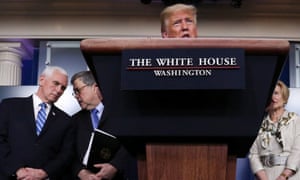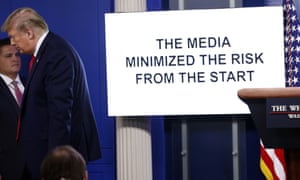‘It will disappear’: the disinformation Trump spread about the coronavirus – timeline
The president was personally warned about the growing crisis beginning in mid-January – but continued to give false assurances to the American public
- Coronavirus – live US updates
- Live global updates
- See all our coronavirus coverage

Photograph: Jonathan Ernst/Reuters
“What a problem. Came out of nowhere.”
That’s how Donald Trump described the coronavirus pandemic in early March, during a televised visit to the Centers for Disease Control and Prevention.
For weeks he had been giving Americans the same advice: “We have it totally under control”; “USA in great shape!”; and, of course, “Fake news”.
But privately, Trump was being warned of a “full-blown Covid-19 pandemic” and “1-2 million” American deaths, according to internal emails, memoranda and other recently unearthed evidence documenting internal deliberations.
It turns out that Trump was personally warned, repeatedly, about the growing crisis beginning in mid-January. But he continued to give false assurances to the American public.
Here’s a timeline of the main notifications Trump received and the disinformation he was simultaneously spreading.
8 January
CDC issues alert
The Centers for Disease Control and Prevention (CDC) issues an alert advising that it “is closely monitoring a reported cluster of pneumonia of unknown etiology (PUE) with possible epidemiologic links to a large wholesale fish and live animal market in Wuhan City, Hubei Province, China”.
18 January
Trump receives briefing
Health secretary Alex Azar calls Trump at his Mar-a-Lago resort in Florida and briefs him on the coronavirus threat, but “Trump spent much of the conversation wanting to talk about vaping”, the AP reported.

21 January
First confirmed US case
A man in his 30s who had traveled to China is hospitalized in Everett, Washington, near Seattle. He tests positive for Covid–19.
22 January
Trump: ‘We have it totally under control’
While attending the Davos conference in Switzerland, Trump makes his first public comment about coronavirus. “We have it totally under control,” he tells the US cable channel CNBC. “It’s one person coming in from China, and we have it under control. It’s going to be just fine.”
27 January
White House aide raises alarm
Joe Grogan, the head of the White House Domestic Policy Council, tells acting chief of staff Mick Mulvaney and others in a meeting that the fight against coronavirus would dominate public life for months and “the administration needed to take the virus seriously or it could cost the president his re-election”, according to a Washington Post report.
29 January
Aide warns of ‘full-blown Covid-19 pandemic’
Economic adviser Peter Navarro warns the National Security Council in a memo that coronavirus could kill half a million Americans and deliver a $5.7tn hit to the economy, Axios reports.
30 January
Azar warns Trump again
As the World Health Organization declares a global health emergency, Azar, the health secretary, again warns Trump about the looming threat. Taking Azar’s call aboard Air Force One en route to a campaign rally, Trump dismisses him as “alarmist”, the New York Times reported.
Trump: ‘Only 5 people in US’
Donald J. Trump
(@realDonaldTrump)Working closely with China and others on Coronavirus outbreak. Only 5 people in U.S., all in good recovery.
January 30, 2020
31 January
US declares ‘public health emergency’
Azar declares a public health emergency. Trump announces a ban on entry to the US for foreign nationals who had recently visited China.
January and February
Intelligence warnings
US intelligence agencies file classified reports warning about global destabilization from a coronavirus pandemic, according to a Washington Post report.
5 February
‘They aren’t taking this seriously’
After a coronavirus briefing with White House officials, senators express concern that the administration is downplaying the threat. “No request for ANY emergency funding,” notes Democrat Chris Murphy of Connecticut.
Chris Murphy
(@ChrisMurphyCT)Just left the Administration briefing on Coronavirus. Bottom line: they aren’t taking this seriously enough.
Notably, no request for ANY emergency funding, which is a big mistake. Local health systems need supplies, training, screening staff etc. And they need it now.
February 5, 2020
19 February
‘When we get into April…’
Addressing a group of governors, Trump predicts the virus will disappear. “I think it’s going to work out fine. I think when we get into April, in the warmer weather, that has a very negative effect on that and that type of a virus.”
21 February
Task force concludes social distancing needed
Following a mock exercise modeling pandemic response, the White House coronavirus task force concludes that aggressive social distancing would be necessary, according to a New York Times report.
23 February
Aide warns of ‘full-blown pandemic’
“There is an increasing probability of a full-blown Covid-19 pandemic that could infect as many as 100 million Americans, with a loss of life of as many as 1-2 million souls,” Navarro, the economics adviser, writes in a memo obtained by Axios.
24 February
Trump: ‘Very much under control’
Donald J. Trump
(@realDonaldTrump)The Coronavirus is very much under control in the USA. We are in contact with everyone and all relevant countries. CDC & World Health have been working hard and very smart. Stock Market starting to look very good to me!
February 24, 2020
25 February
‘I have not heard anything other’
In a CDC telebriefing, Nancy Messonnier the Director of the Center for the National Center for Immunization and Respiratory Diseases, says: “Ultimately, we expect we will see community spread in this country” and “disruption to everyday life may be severe. But these are things that people need to start thinking about now.”
At a news conference in New Delhi, Trump says: “You may ask about the coronavirus, which is very well under control in our country. We have very few people with it, and the people that have it are – in all cases, I have not heard anything other.”
On the way back from India, Trump reportedly called Azar and complained that Messonnier was scaring the stock market.
Donald J. Trump
(@realDonaldTrump)CDC and my Administration are doing a GREAT job of handling Coronavirus, including the very early closing of our borders to certain areas of the world. It was opposed by the Dems, “too soon”, but turned out to be the correct decision. No matter how well we do, however, the…..
February 26, 2020
Larry Kudlow, the director of the national economics council, is asked about Messonnier’s comments on CNBC.
“We have contained this,” he says. “I won’t say airtight, but it’s pretty close to airtight.”
26 February
‘Fake News’
“The infection seems to have gone down over the last two days,” Trump says at a White House news conference. “We’re going to be pretty soon at only five people. And we could be at just one or two people over the next short period of time.”
Donald J. Trump
(@realDonaldTrump)Low Ratings Fake News MSDNC (Comcast) & @CNN are doing everything possible to make the Caronavirus look as bad as possible, including panicking markets, if possible. Likewise their incompetent Do Nothing Democrat comrades are all talk, no action. USA in great shape! @CDCgov…..
February 26, 2020
27 February
‘It will disappear’
“It’s going to disappear,” Trump says in a White House briefing. “One day it’s like a miracle, it will disappear.”
29 February
First confirmed US death
The US marks its first confirmed coronavirus death, a man in his 50s near Seattle.
Almost six weeks after the first case of coronavirus was confirmed, the Food and Drug Administration allows laboratories and hospitals to conduct their own Covid-19 tests to speed up the process.
5 March
Trump: ‘Highest rating ever’
Donald J. Trump
(@realDonaldTrump)Gallup just gave us the highest rating ever for the way we are handling the CoronaVirus situation. The April 2009-10 Swine Flu, where nearly 13,000 people died in the U.S., was poorly handled. Ask MSDNC & lightweight Washington failure @RonaldKlain, who the President was then?
March 5, 2020
6 March
Trump visits the CDC laboratories and calls the pandemic “an unforeseen problem”.
“What a problem,” he says. “Came out of nowhere.”
The stock market begins to plunge in earnest, with the Dow Jones Industrial Average shedding more than 20% in next two weeks.
9 March
Flu comparison
Donald J. Trump
(@realDonaldTrump)So last year 37,000 Americans died from the common Flu. It averages between 27,000 and 70,000 per year. Nothing is shut down, life & the economy go on. At this moment there are 546 confirmed cases of CoronaVirus, with 22 deaths. Think about that!
March 9, 2020
9 March
‘4m tests by the end of the week’
Former Trump homeland security adviser Tom Bossert publishes an op-ed: “It’s now or never for the US if it hopes to keep coronavirus from burning out of control.”
In an evening news conference, White House officials say the United States will have tested 1 million people that week and thereafter perform 4m tests per week. “We’ve been moving progressively to bring that test closer and closer and closer to the patient,” Azar says.
The number was false by multiple orders of magnitude. Through 12 March, the federal Centers for Disease Control and Prevention (CDC) had completed 4,000 tests – not 4m.
10 March
‘When people need a test, they can get a test’
“When people need a test, they can get a test,” Trump says at a White House briefing. “When the professionals need a test, when they need tests for people, they can get the test. It’s gone really well.”
12 March
A ‘million tests out now’
Dr Anthony Fauci tells Congress that the United States does not have sufficient testing. “The system is not really geared to what we need right now,” he says. “That is a failing. Let’s admit it.”
But Trump says at a White House briefing there are a “million tests out now” and “if you go to the right agency, if you go to the right area, you get the test”.
13 March
‘I don’t take responsibility at all’
Trump declares a national emergency over coronavirus. Trump announces a supposed Google site under development to help people across the country find testing, but it is a sham.
“We’ve been in discussions with pharmacies and retailers to make drive-through tests available in the critical locations identified by public health professionals,” Trump adds, but a month later only a handful had materialized.
Says Trump: “I don’t take responsibility at all.”



